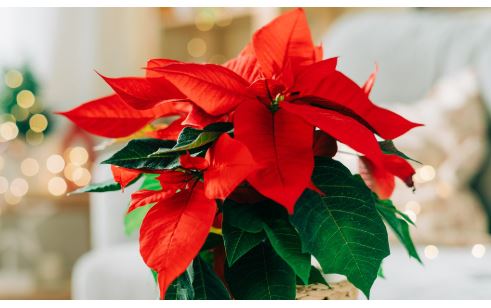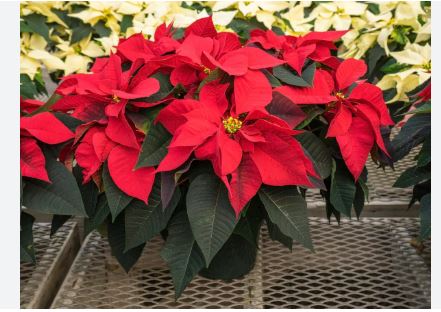
The Poinsettia, scientifically known as Euphorbia pulcherrima, belongs to the family Euphorbiaceae, a diverse group of plants characterized by milky sap and unique floral structures. It is classified under the order Malpighiales, and its genus, Euphorbia, includes over 2,000 species ranging from succulents to shrubs. Euphorbia pulcherrima is a perennial shrub, though it is often grown as an annual or seasonal potted plant in many regions.
The plant’s vibrant bracts, often mistaken for petals, are modified leaves that surround its small, inconspicuous flowers, a trait typical of the Euphorbiaceae family. Its taxonomic placement reflects its adaptation to warm, tropical environments, aligning it with other euphorbias known for their ornamental or ecological significance.
Identifying Characteristics
Poinsettias are easily recognized by their colorful, star-shaped bracts, which are commonly bright red but can also be pink, white, cream, yellow, or marbled in modern cultivars. These bracts surround tiny, clustered flowers called cyathia, which lack true petals and are typical of the Euphorbia genus.
The plant typically grows 2–13 feet tall in its natural habitat as a shrub, but cultivated varieties are often kept compact (1–3 feet) through pruning or chemical growth regulators. Its dark green, ovate leaves are lobed, with a slightly toothed edge, and measure 3–6 inches long.
The stems are hollow, brittle, and exude a toxic, milky latex when cut, which can irritate skin and eyes. Poinsettias bloom in response to short day lengths (photoperiodism), typically flowering in late fall to winter, making them a popular holiday plant.
History
The Poinsettia has a rich cultural and horticultural history. Native to Mexico, it was revered by the Aztecs, who called it cuetlaxochitl and used its bracts for red dye and its sap for medicinal purposes, such as treating fevers. Spanish colonizers noted its use in religious ceremonies, and by the 17th century, Franciscan monks incorporated it into Christmas celebrations due to its winter blooming and red-and-green symbolism.
The plant was introduced to the United States in the 1820s by Joel Roberts Poinsett, the first U.S. ambassador to Mexico, whose name became associated with the plant. Commercial cultivation began in the early 20th century, particularly in California, where the Ecke family revolutionized Poinsettia production by developing compact, long-lasting cultivars and promoting them as Christmas symbols. Today, Poinsettias are a global holiday staple, with millions sold annually, especially in North America and Europe.
Native Area
Poinsettias are native to Mexico and Central America, where they grow wild in tropical deciduous forests along the Pacific slopes from southern Sinaloa, Mexico, to Guatemala. They thrive in warm, semi-arid to humid environments at elevations of 1,000–4,000 feet, often found on rocky hillsides or in open woodlands.
In their native range, Poinsettias are large, leggy shrubs or small trees, blooming during the dry season (November to February) in response to shorter days. Their natural habitat reflects their preference for well-drained soils and partial shade, though they can tolerate full sun in cooler conditions.
Distribution & Habitat
While native to Mexico and Central America, Poinsettias have been widely distributed through cultivation and are now grown commercially in many parts of the world, including the United States, Europe, Asia, and Australia. They are primarily cultivated in greenhouses or as indoor potted plants due to their frost sensitivity, thriving in USDA Zones 9–11 as outdoor perennials.
In non-native regions, they are grown as seasonal houseplants or outdoor annuals, requiring controlled environments to induce flowering. In the wild, Poinsettias prefer well-drained, slightly acidic to neutral soils (pH 5.5–6.5) and partial shade, though cultivated plants are often grown in full sun to enhance bract coloration. Their global spread is largely due to their ornamental value, with major production centers in California, the Netherlands, and Colombia.
Landscape and Other Uses

In landscaping, Poinsettias are used primarily as seasonal outdoor plants in frost-free climates, where they can be planted in garden beds, borders, or as accent shrubs to add vibrant color during winter months. In tropical regions, they can grow into large shrubs or small trees, providing year-round greenery and seasonal blooms.
As houseplants, Poinsettias are a hallmark of holiday decor, valued for their festive red, white, or pink bracts and ability to thrive indoors with proper care. Beyond ornamentation, their milky sap has been used in traditional medicine in Mexico for treating skin conditions and fevers, though its toxicity requires caution.
The sap’s irritating properties have also been explored for potential industrial uses, such as in adhesives, but this remains limited. Poinsettias are also used in floral arrangements, though their primary cultural significance lies in their association with Christmas, symbolizing joy and celebration.
Cultivars of Poinsettia
- Winter Rose: Features curled, rose-like bracts in red, pink, or white, with a compact growth habit ideal for potted displays.
- Freedom Series: Includes Freedom Red, Freedom White, and Freedom Marble, known for their vibrant colors and strong, upright stems, popular for holiday sales.
- Prestige Red: A classic red cultivar with large, vivid bracts and excellent branching, widely used in commercial production.
- Ice Punch: Offers unique red bracts with white centers, creating a striking, festive contrast.
- Jingle Bells: Features red bracts speckled with pink or white, resembling snowflakes, adding a whimsical touch to holiday decor.
- Princettia Series: Compact plants with soft pink, white, or bicolor bracts, bred for early blooming and suitability as tabletop plants.
- Christmas Glory: Known for its deep red bracts and vigorous growth, ideal for both indoor and outdoor use in warm climates.
- Sonora White Glitter: Displays red bracts with white speckles, offering a festive, sparkling appearance.
- Autumn Leaves: Features warm yellow to peach bracts, a departure from traditional holiday colors, suited for fall displays.
- Peppermint Mocha: Combines creamy white and pink bracts with a subtle red blush, popular for modern, non-traditional holiday arrangements.
- Visions of Grandeur: Offers large, soft pink to cream bracts with a ruffled texture, ideal for premium markets.
- Luv U Pink: A vibrant pink cultivar with compact growth, perfect for small spaces or gift plants.
Cultivation of Poinsettia Plant
Propagation Methods
Poinsettias are primarily propagated through stem cuttings, as seeds are rarely used due to genetic variability and slow growth. Take 4–6 inch cuttings from healthy, non-flowering stems in late spring or early summer, dip them in rooting hormone, and plant in a well-drained, sterile medium like perlite or peat moss.
Maintain high humidity (80–90%) and temperatures of 70–75°F (21–24°C) to encourage rooting within 2–3 weeks. Commercial growers often use tissue culture for uniform, disease-free stock.
Soil and Media
Poinsettias thrive in well-drained, slightly acidic to neutral soil with a pH of 5.5–6.5. For potted plants, use a soilless mix containing peat moss, perlite, and vermiculite to ensure good aeration and drainage.
In garden settings, amend heavy soils with organic matter like compost to improve structure. Avoid waterlogged conditions, as Poinsettias are prone to root rot in overly wet media.
Light Requirements
Poinsettias require bright, indirect light for vegetative growth, with 1,500–3,000 foot-candles in greenhouse settings or 4–6 hours of filtered sunlight daily.
To induce flowering, they need strict photoperiod control: 12–14 hours of uninterrupted darkness per night for 8–10 weeks starting in early fall (around late September). Any light exposure during this period, even brief, can delay or prevent bract formation and flowering.
Temperature Control
Ideal daytime temperatures for Poinsettias are 65–75°F (18–24°C), with nighttime temperatures of 60–65°F (16–18°C). Avoid temperatures below 50°F (10°C), as cold stress causes leaf drop and stunted growth. Protect plants from drafts and sudden temperature changes, especially in indoor settings.
In warm climates (USDA Zones 9–11), Poinsettias can be grown outdoors year-round, but in cooler regions, they are treated as seasonal houseplants.
Watering Practices
Water Poinsettias when the top inch of soil feels dry, ensuring thorough irrigation without waterlogging. Overwatering leads to root rot, while underwatering causes wilting and leaf drop.
In pots, ensure drainage holes prevent standing water. Maintain moderate humidity (40–60%) to prevent leaf desiccation, using pebble trays or humidifiers indoors. Avoid wetting foliage to reduce fungal disease risk.
Fertilization
Feed Poinsettias with a balanced, water-soluble fertilizer (e.g., 20-20-20) every 2 weeks during active growth (spring to early fall), diluted to half strength. Once bract formation begins, switch to a low-nitrogen, high-potassium fertilizer (e.g., 15-0-15) to support flowering and bract coloration.
Avoid over-fertilizing, as excess nitrogen causes leggy growth and reduced bract vibrancy. Monitor for nutrient deficiencies, such as yellowing leaves (nitrogen deficiency) or poor bract development (potassium deficiency).
Pruning and Pinching
To encourage compact, bushy growth, pinch back young Poinsettias when they reach 6–8 inches tall, removing the top 1–2 inches of each stem. Repeat pinching every 4–6 weeks until mid-August to promote branching.
After flowering, prune plants back to 6–8 inches in early spring to rejuvenate for the next season. For outdoor shrubs, regular pruning maintains shape and prevents legginess. Always wear gloves when pruning to avoid skin irritation from the toxic sap.
Pest Management
Common pests include whiteflies, spider mites, aphids, and mealybugs, which can be controlled with insecticidal soap, neem oil, or systemic insecticides. Whiteflies are particularly problematic in greenhouses, requiring regular monitoring and sticky traps for early detection.
Maintain good air circulation and avoid overwatering to reduce pest pressure. Quarantine new plants to prevent introducing pests to established crops.
Disease Control
Poinsettias are susceptible to fungal diseases like powdery mildew, botrytis (gray mold), and root rot (caused by Pythium or Rhizoctonia). Prevent diseases by ensuring proper drainage, avoiding overhead watering, and maintaining good ventilation.
Apply fungicides preventatively in humid conditions, and remove infected plant parts promptly. Bacterial leaf spot and viral diseases can also occur, so use disease-free stock and sterilize tools to minimize spread.
Photoperiod Manipulation for Flowering
Poinsettias are short-day plants, requiring long, uninterrupted nights to trigger bract development and flowering. Starting in late September or early October, provide 12–14 hours of complete darkness nightly by covering plants with a blackout cloth or moving them to a dark room.
Daytime light should be bright but not excessive. Commercial growers use automated shading systems to ensure precise light control, targeting blooms for the holiday market (November–December).
Growth Regulators
To maintain compact growth for potted plants, commercial growers often apply chemical growth regulators like paclobutrazol or daminozide to reduce stem elongation. These are typically applied as foliar sprays or soil drenches during early growth stages.
Home growers can achieve similar results through pinching and controlled lighting, though care must be taken to avoid overuse of chemicals, which can stunt plants excessively.
Post-Harvest Care for Potted Plants
After purchase or flowering, Poinsettias can be maintained as houseplants with proper care. Keep them in bright, indirect light, water sparingly, and maintain temperatures above 60°F (16°C). To rebloom the following year, prune back in spring, repot if needed, and follow the photoperiod schedule starting in fall.
Remove faded bracts and dead leaves to maintain appearance and prevent disease. For cut stems used in arrangements, sear the cut ends with a flame or dip in hot water to stop sap flow and extend vase life.
Regional and Seasonal Considerations
In frost-free regions (USDA Zones 9–11), Poinsettias can be grown as perennial shrubs, planted in spring for year-round growth and winter blooms. In colder climates, they are grown as indoor potted plants or greenhouse crops, with seeds or cuttings started 6–8 months before the desired bloom time (e.g., April–May for December flowering).
Protect outdoor plants from excessive rain or wind, and provide afternoon shade in hot climates to prevent leaf scorch. Greenhouse cultivation allows year-round production, with temperature, light, and humidity tightly controlled to meet holiday demand.